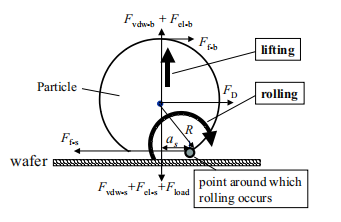Abstract. This study focuses on the analysis of the forces and moments acting on a particle to reveal the particle-removal mechanisms during a scrubbing process. The brush-asperities/substrate contact geometry during scrubbing is fifirst investigated. The forces and moments under difffferent lubrication modes are then determined by means of a mixed theoretical-experimental method. Finally, the analysis of the forces and moments is used to explain the experimental results and to fifind out the particle-removal mechanisms.
Introduction
To ensure high device yields, wafer surface contamination and defects must be monitored and controlled at several points in the semiconductor manufacturing process. Brush scrubbers are among the tools used to achieve such a control, especially after a chemical-mechanical-planarization process. Although brush scrubbing has been used since the early 1990s in production, the particle-removal mechanisms during scrubbing is still under heavy discussion [1–3]. This study mainly focuses on the analysis of the forces acting on a particle during scrubbing. Theoretical calculation and experimental results will show that these forces and moments are the key to understanding the particle-removal mechanisms during scrubbing.
Theoretical Approach
There are two main groups of forces on particles during scrubbing: (i) adhesion forces including the van de Waals force Fvdw-s and the electrostatic force Fel-s between a particle and a substrate, and (ii) mechanical forces such as the hydrodynamic drag force FD and contact forces between a particle and brush asperities, such as frictional force Ff , brush load Fload, van de Waals force Fvdw-b, and electrostatic force Fel-b. A schematic description of the forces is illustrated in Fig. 1. The adhesion forces can be approximated by theoretical calculations [4]. The shear stress τ obtained by measuring the power consumption of a brush motor allows to calculate the thickness h of the flfluid fifilm between a substrate and a brush based on the defifinition of the dynamic viscosity (h = ηV /τ , with η the dynamic viscosity of the flfluid and V the brush/wafer relative velocity). The drag force is equal to FD = 6πR2fDτ , where R is the particle radius, and fD is a drag coeffiffifficient which varies from 1.7 to 10 and increases as 2R/h [5]. The frictional force Ff is defifined as Ff = πa2 pbτ , where apb is the brush/particle contact area, which can be calculated by considering the Young’s modulus, Poisson ratio and the brush/substrate pressure [6]. The brush load Fload may be approximated by the product of the brush/substrate pressure and the particle cross section area. The brush/particle van de Waals force Fvdw-b and electrostatic force Fel-b can be derived from theoretical calculations [4,6]. It should be noted that during scrubbing a particle receives an additional drag torque TD when it is attached to the wafer surface: TD = 4πR3 τ [7]. Two possible incipient motions of the detachment of particles from a wafer during scrubbing, namely lifting and rolling, are also illustrated in Fig. 1. Removal criteria for rolling involve the moments of the forces around the reference point shown in Fig. 1.

Experimental
The test wafers were 200 mm p-type silicon with a 150-nm nitride layer deposited on a 15-nm pad-oxide. Before use, the wafers were cleaned using an O3-last Imec-clean. Particles were colloidal SiO2 particles with diameter of 20, 34, 78 and 126 nm. Controlled contamination of the wafers was done by immersion in a particle-contaminated bath at pH ≈ 0 (HCl), followed by over flflow rinse and Marangoni dry. Based on the haze method [8], the fifinal particle surface-concentration (σpsc) was determined by measuring the haze of the wafer using a light-scattering apparatus (KLA-Tencor SP1 DLS). Scrubbing was done on a double-sided brush station, Damasclean from Mattson or DSS-200 from Ontrak, using polyvinyl acetal (PVA) brushes from Texwipe .
Results and Discussion Lubrication regime.
Depending on the lubrication regime, a particle is subject to difffferent types of mechanical forces and moments: contact forces (or moments) in a boundary lubrication regime but hydrodynamic forces (moments) in a hydrodynamic lubrication regime. Therefore, we fifirst determine the flfluid fifilm thickness h at various brush/wafer relative velocities and pressures (Fig. 2). Clearly, h increases with the velocity but decreases with the pressure and h is of the same range as the particle size under study. However, this thickness is only an average value across a full wafer. In reality, the pressure can vary a lot locally when the system is in motion. Bahten et al. have reported that the maximum pressure can be up to 3.5 times as large as the average [3], which implies that some localized brush asperities can come into much closer contact with the wafer surface. According to an extrapolation from Fig. 2a, the fifilm thickness can be 40 nm at a maximum local pressure of 15 kPa. Considering the surface roughness of a typical PVA brush is in tens of micrometers, the brush/wafer contact is believed to be in a mixed lubrication, i.e. brush has partial contact with wafer/particle and partial contact with flfluid.
下一篇: 旋涂玻璃材料的旋涂及烘烤